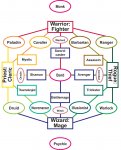Blue
Ravenous Bugblatter Beast of Traal
Okay ... I love 5e, so I'm going to suggest a very NOT 5e system - because if it was a 5e system Id rather just stay with / expand 5e.
But still keep it recognizable D&D. Hmm.
I'd love to see few classes/subclasses, but more mixing and matching between them without removing primary focus - a bit like subclasses do now where they add a theme to an existing class, vs. multiclassing that stop advancement in one class to add from another class.
Making this up as I go along, say you had Casters, Tanks, Skill-monkeys (includes Faces), Snipers, Skirmishers and Pet Owners. Snipers is the horrible name I just came up with for ranged combatants - both a classic archer and a EB warlock would fit in it. Skirmishers are great at moving, and likely have some sort of attack that goes with it, like sneak attack. Pet Owners are beastmasters, necromancers, summoning casters, and their friends based on what you flavor it with.
(Side note written when I got to the end: I've fallen into a trap. D&D classes for the last few editions are so focused mechanically around "everyone is good at combat" that my classes all focused on that to varying degrees, with Skirmisher and Sniper as least descriptive.)
Casters will need to be divvied up more, haven't thought about how. Perhaps by what you flavor them with. So a Tank / Caster would have protection and melee boosting spells, maybe some touch based ones.
A classic Wizard would be a Caster with some Skill-Monkey. A traditional D&D cleric would be Caster with Tank bits for the weapons and armor. Rogues could be Skill Monkey with Skirmisher or vice Versa. Bards would be Skill-monkey Casters. Rangers type archers are skill-monkey snipers. Etc. But you could have other combos. Want a Tank/Skill-monkey? Skirmisher Caster?
So each class is both a framework, and the same primary features but probably with slower acquisition and less secondary features as a subclass. So a caster is low HPs, no armor, simple weapons, full casting, and nifty casting boost features. Adding fighter as a subclass to it will add some HPs and weapon/armor, and some of the main fighter boosts.
Now, before I started writing I was thinking the Paladin was Fighter with a Cleric subclass, but then I lose Cleric as a main class because really not all divine casters need to be heavily armored and proficient with a mace. (I'm old-school.) So maybe what we need is some additional sub-classes that anyone can take. Or better yet (see, I'm coming up with this as I write it), an additional axis of flavoring and thematic components that everyone takes, much like the Warlock chooses a patron.
So "Divine" would be one of those. Or maybe various domains? That might be too granular, but on the other hand it might work well for your Pet Owner / Skirmisher of the Goddess of Hunting.
Eh, I've tossed a bunch of half-formed thoughts at the wall, let's see what's worth discussing.
But still keep it recognizable D&D. Hmm.
I'd love to see few classes/subclasses, but more mixing and matching between them without removing primary focus - a bit like subclasses do now where they add a theme to an existing class, vs. multiclassing that stop advancement in one class to add from another class.
Making this up as I go along, say you had Casters, Tanks, Skill-monkeys (includes Faces), Snipers, Skirmishers and Pet Owners. Snipers is the horrible name I just came up with for ranged combatants - both a classic archer and a EB warlock would fit in it. Skirmishers are great at moving, and likely have some sort of attack that goes with it, like sneak attack. Pet Owners are beastmasters, necromancers, summoning casters, and their friends based on what you flavor it with.
(Side note written when I got to the end: I've fallen into a trap. D&D classes for the last few editions are so focused mechanically around "everyone is good at combat" that my classes all focused on that to varying degrees, with Skirmisher and Sniper as least descriptive.)
Casters will need to be divvied up more, haven't thought about how. Perhaps by what you flavor them with. So a Tank / Caster would have protection and melee boosting spells, maybe some touch based ones.
A classic Wizard would be a Caster with some Skill-Monkey. A traditional D&D cleric would be Caster with Tank bits for the weapons and armor. Rogues could be Skill Monkey with Skirmisher or vice Versa. Bards would be Skill-monkey Casters. Rangers type archers are skill-monkey snipers. Etc. But you could have other combos. Want a Tank/Skill-monkey? Skirmisher Caster?
So each class is both a framework, and the same primary features but probably with slower acquisition and less secondary features as a subclass. So a caster is low HPs, no armor, simple weapons, full casting, and nifty casting boost features. Adding fighter as a subclass to it will add some HPs and weapon/armor, and some of the main fighter boosts.
Now, before I started writing I was thinking the Paladin was Fighter with a Cleric subclass, but then I lose Cleric as a main class because really not all divine casters need to be heavily armored and proficient with a mace. (I'm old-school.) So maybe what we need is some additional sub-classes that anyone can take. Or better yet (see, I'm coming up with this as I write it), an additional axis of flavoring and thematic components that everyone takes, much like the Warlock chooses a patron.
So "Divine" would be one of those. Or maybe various domains? That might be too granular, but on the other hand it might work well for your Pet Owner / Skirmisher of the Goddess of Hunting.
Eh, I've tossed a bunch of half-formed thoughts at the wall, let's see what's worth discussing.




